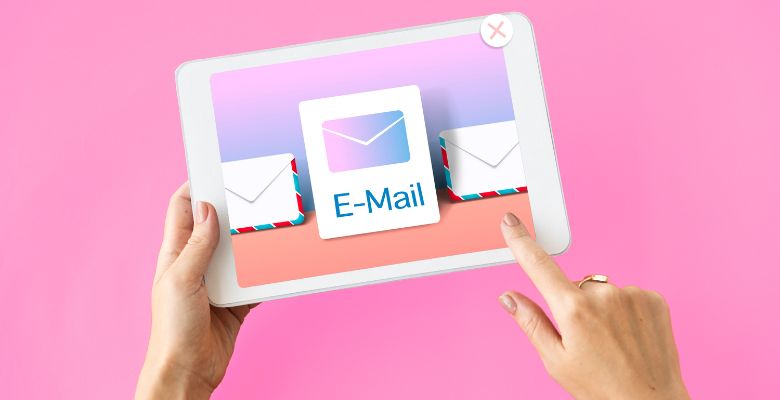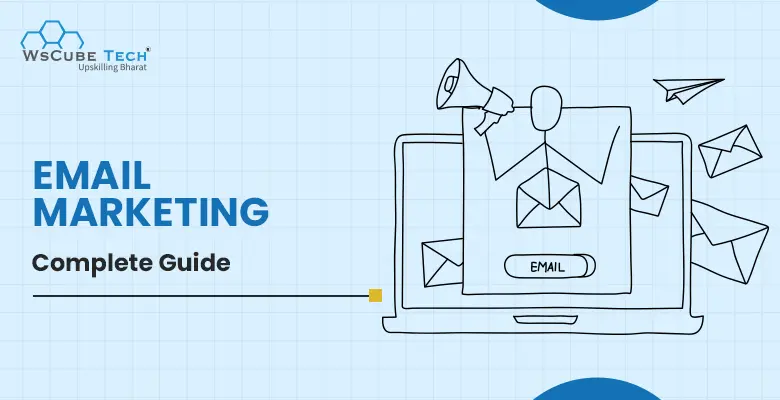Despite the rise in social media platforms, email marketing is still the best-known and most effective form of digital communication. It is the most profitable form of direct marketing, generating an ROI of $42 for every $1 spent. Some business professionals, marketers, and beginners still wonder what is email marketing and how does it work. Can it be beneficial for their business goals?
Let’s understand the meaning of email marketing and how does email marketing work in the comprehensive write-up.
It is one of the top marketing strategies because it is budget-friendly and saves time. Also, when done following a plan, it can generate sales, drive traffic and maximize profits.
It is a vast discipline with plenty of email marketing tools and techniques to execute a successful campaign. And, if you’re a beginner and want to know more about email marketing, hang in tight; we’ll discuss on:
- Email Marketing Definition and Meaning
- What are the advantages and disadvantages of email marketing?
- How many types of email marketing are there?
- What is the best email marketing strategy?
Upskill Yourself With Live Training (Book Free Class)
What is Email marketing? Meaning & Definition
It is the digital marketing process used to send promotional emails to customers/subscribers. It drives sales or generates leads which help to build a community around your brand.
Modern email marketing no longer focuses on one mail for the mass; instead, now it is more about consent, segmentation, and customization.
Hence, whether you are a business looking to use this strategy or someone preparing for digital marketing interview questions, knowing what is email marketing is crucial.

How Does Email Marketing Work?
Wondering how email marketing works? It is not a complicated process.
Email marketing is fairly intuitive and often automated. Businesses, with the help of an Email Service Provider (ESP), send marketing emails and manage the campaigns.
ESP facilitates the email marketing process. It ensures:
- email deliverability – the emails land in the inbox or not.
- helps to design newsletters
- has automation capabilities
- can personalize content
These features help you build a mailing list, engage with subscribers, and strengthen customer relationships. Nowadays, it is no longer rocket science as one can learn it with an online digital marketing course or with reliable resources on the internet.

Suggested Reading: SEO vs SEM Difference in Digital Marketing: Explained in Simple Terms
Key Elements of Email Marketing Campaigns
Apart from ESP, an effective email marketing campaign requires three essential elements, which are:
1. An email list
The email list contains the email addresses of the interested subscribers who have opted-in to receive emails from you.
Permission-based marketing is vital to confirm with data protection laws and safeguard the integrity of the brand. After all, nobody likes a spammer.
There are many ways to build your email list, by creating a lead magnet (also known as an offer) which your audience is interested in, like a coupon or e-newsletters in exchange for the email addresses. You can use the best email marketing tools to start building an email list easily.
2. An Email Service Provider
An email service provider (ESP) lets you segment your audience, manage your list, and help design and distribute email marketing campaigns.
ESP allows you to automate actions based on your target audience’s behaviour. These enable you to connect with your audience, generating engagement and improving conversion rates.
3. Clearly defined goals
The business goals differ from one to another. Brands can use email marketing to achieve many goals, for example:
- boost brand awareness
- drive sales
- generate leads
- keep audience engaged
- increase customer loyalty
To execute a successful marketing campaign, your email list, ESP and goals must align.
Firstly, segment your audience and generate your email list according to their demographics or actions.
Further, create a series of emails customized according to your audience to deliver your business goal.
Lastly, use your ESP to automate the process and monitor your campaign.
Interview Questions for You to Prepare for Jobs
| Digital Marketing Interview Questions | SEO Interview Questions |
| Email Marketing Interview Questions | Content Writing Interview Questions |
Different Types of Email Marketing Campaigns
Now that you know email marketing definition and how does email marketing work, it’s time to understand the primary email marketing types.
It consists of some marketing emails that brands use to provide information or promote their product. Here we have discussed a couple of different types of email marketing.
1. Promotional emails
The marketing campaigns are used to promote the brand, product, new release, webinar, or ebook. A campaign could consist of a series of emails for days or weeks.
Promotional emails have a clear call-to-action (CTA) that you want the reader to take. It can be to visit the webpage or purchase the product.
This type of marketing is used or required when in line with the rhythm of your business. For instance, if you are offering an online digital marketing course and want to promote it, then you can send a promotional email regarding it to your subscribers.
2. Informational emails
Informational emails can be of multiple types, like newsletters or any announcement.
Newsletters:
A newsletter shares the news related to your business (new milestones reached, new product capabilities) or highlights a specific product/service. It can be sent according to a set schedule which will help keep the subscribers engaged and maintain a consistent connection.
Newsletters don’t just have to be about ‘news’. It can also be a one-to-one letter to your subscribers about anything that interests them.
Take this as an opportunity to share thoughts, insights, tips, or whatever brings the most value to your audience. For example, if we have published this blog on what is email marketing and how does it work, then we can include its link in the newsletter and offer information to our audience.
Announcements:
Sometimes, announcement and newsletter emails blend with each other in company marketing campaigns. Announcement emails can give information about anything, from a new product release to an upcoming sale.
You can make announcements about some important changes to your company’s product or potential events that you’re planning. These messages won’t happen as frequently as any other marketing campaign.
3. Transactional emails
Transactional emails are messages that build a relationship with your customers. These messages include order confirmations and tracking updates.
For example, if a learner has enrolled in our online content writing course, then a transaction email will be sent to him to confirm his seat and stay updated about the upcoming batch.
4. Automated emails
Automated emails are a combination of various promotional emails intended to move the subscribers along the sale funnel or push them to take action. You may send automated emails to “welcome” users that join your email list.
Automated emails also include messages about abandoned carts or wishlists to lure them back to the store. Brands also send birthday emails to customers to boost brand affinity.

Benefits of Email Marketing (Why Email Marketing is Important?)
After understanding what is email marketing and how does it work, the next step should be to know the top email marketing benefits in 2024.
1. Permission-based Marketing
When customers trust you with their email address, they willingly give you access to land in their inboxes. Gaining permission is better than showing up uninvited and increases the chances of conversion and engagement.
Related Article: Top 30 Most Asked Email Marketing Interview Questions and Answers
2. Accessibility
Email marketing is accessible to all age groups and opens the doors to communicating with your audience.
In this tech-savvy generation, people tend to check their email daily, and your email is likely to be viewed.
3. Gives you more control
Unlike other social media platforms, you own your mailing account. Therefore, if any platform ceases to exist, all your hard work sinks with it.
With email, you have direct contact with your audience. And the intimacy of email allows you to build a one-to-one relationship with your subscribers.
4. More personalization capabilities
Another point that proves the email marketing importance is that you can use more psychographic or demographic data to create personalized campaigns for the targeted people. Research has concluded that personalization can increase revenue by up to 760%.
Suggested Reading: Top 10 Free Email Marketing Tools in 2024
5. Easily measurable
Another characteristic of email marketing is that it can be easily measured. This is important because if you want to improve, you must measure the campaign’s effectiveness.
When you run an email campaign, do you know how many people viewed your emails, did your email land up in the spam, and how many sales you generated? Automated email marketing makes measuring your campaign easier. Hence, if you are not yet good at it, then going for a reliable digital marketing course in India or a free email marketing course with certificate can do wonders for you.
What Are Disadvantages of Email Marketing?
Now that you have a good idea of what is email marketing and how does it work, as well as the pros of it, let’s now know about some of its cons.
1. Competitive platform
Standing out in a cluttered email box can be challenging. You need to be creative to stand out in the crowd, so your email gets noticed and read.
2. Email deliverability
The challenge of getting your email to land in receivers’ inboxes is tough. Deliverability rates are the ratio of emails sent versus the number of emails that made it to your targeted customer’s inbox. To make a campaign effective, you must contend that your emails are delivered and address all the deliverability issues.
3. Retaining subscribers
Many businesses that struggle with retaining customers sometimes buy email lists in hopes that they’ll convert potential customers by sending unsolicited messages to people who are in no way affiliated/interested in your brand or product. This cannot be a great practice to convert customers as it is highly unlikely that people will respond, and messages may be marked as spam.
4. Mobile-friendly emails
People don’t have time to check emails from their laptops. Most consumers check emails from their smartphones in the morning or while reaching their destination in the car. So you don’t have much time to grab their attention. If your email is not mobile-friendly, you’re forcing your customers to scroll up-down or left-right to grasp the message, which means you’ll lose the customer.
5. Struggle in growing email list
Planning to implement a successful email campaign can be a struggle if you’re new to the business. In many businesses, marketers are wearing multiple hats; they manage schedules and employees and also have to build an email list, segment customers, and create personalized emails, all while tracking metrics. This can be quite challenging.

Email Marketing Strategy Plan for 2024
To make an effective campaign, you have to make a great email marketing strategy plan. Here are some steps that you can easily follow and drive results in 2024.

1. Build your own list
The first step towards launching a successful email campaign is to build a secure and healthy email list. To build such a list, you can offer coupons, gift vouchers, or other compelling offers. It can be through your website, in your store, or at an event, but make sure customers are opting-in to receive your emails.
2. Practice email list hygiene
The biggest asset of any email marketing strategy is the subscriber list. So it is important to keep the email list updated. Also, at regular intervals, remove the inactive subscribers and email addresses that are no longer in use.
You might feel that cleaning out your email list is counter-productive, but it isn’t. By keeping inactive users in your email lists, your engagement levels might drop.
Most email service providers have the option to remove inactive subscribers automatically. So you won’t have to spend your time trying to update the list manually.
3. Send targeted and segmented emails
Stay in contact with your customers by sending personalized and segmented emails to your customers. This will help build deeper connections and nurture relationships.
Make sure to send emails regularly to keep your audience engaged. Entertain or educate them with a series of emails on a specific topic they opted-in for. This will prevent them from spamming.
4. Define the clear action that you want the reader to take
In addition to the creative subject line and layout of the email, you must focus on the goal of each and every email. Ask yourself, what actions do you want the reader to take after reading the email, or did they learn something new about your brand, product, or service? Create the email in a way you want the actions to take place.
5. Track the right KPIs
Email marketing is more than sending emails to your subscribers. It also entails monitoring the performance of your campaigns. With the help of KPIs, you can check the effectiveness of the campaign and know how many subscribers are interested in your company. People who are still wondering why learn digital marketing now have the answer that everything is crucial for driving success online.
Free Courses for You
| Course Name | Course Name |
| Google Tag Manager Course | Affiliate Marketing Course |
| Semrush Course | Video Editing Course |
| Blogging Course | Email Marketing Course |
| Shopify Course | Photoshop Course |
Wrapping Up:
Hope this write-up helped you understand the meaning of email marketing and how it works. Moreover, knowing its pros and cons is also important for you to follow the right steps and create a solid email marketing strategy for your business.
Just like any other marketing strategy, email marketing also requires a foolproof plan to start with. Take time to understand more about email marketing; for that, you can take our email marketing course for free and build the campaigns that best suit your brand or become an email marketing expert.
Read more blogs:



